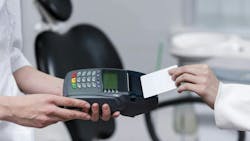More patients are wasting FSA dollars—here's how dental practices can help
New data from the Employee Benefits Research Institution (EBRI) yielded surprising results after investigating of over 3.2 flexible spending accounts (FSAs) in 2022. Although they discovered a rise in average contributions, almost half of account holders are forfeiting their income to employers.
This is especially concerning because, unlike with savings accounts, FSA users risk losing funds if they are not spent by the end of the year. Ultimately, many account holders need additional support from employers during their FSA enrollment period to better understand the terms and conditions of their accounts. The EBRI plans to keep monitoring this forfeiture trend to assess its trajectory moving forward.
There are many reasons people object to or delay needed dental treatment, from fear to lack of trust to just not taking health concerns seriously, but money is always a frequent concern. If consumers are leaving funds behind in their accounts every year, but still think they can’t afford dental care, dental professionals have an opportunity to create a win-win situation for patients and practices.
Use it or lose it
In the dental industry, failing to take advantage of FSA benefits may mean that patients are losing out on valuable resources. Clinicians can potentially increase patient engagement, oral hygiene, and improve financial outcomes for both the patient and practice by helping them understand their FSAs.
To put things into perspective, forfeitures in 2022 averaged $441—or roughly $1.4 billion for all accounts reviewed (Imagine if some of that money was spent at your practice instead). This number is noticeably higher from 2019, where forfeitures averaged up $339 per person and $1.08 billion total.1 Some companies offer FSA rollover features and grace periods (90 days into the next year), but these are not always well understood by consumers, or discussed by employers. With so much money and resources unused, it’s paramount for patients to take advantage of their yearly FSA benefits. The EBRI found that 73% of younger patients were more likely to forfeit their FSA funds, which may be partly caused by their lower health care expenses.1
Improving patient care
FSA accounts can cover a wide range of dental procedures—basically, anything that is not cosmetic (such as whitening and veneers). Many people connect FSA accounts to doctor’s offices, but not necessarily the dentist. Practices can take simple steps toward encouraging patients to use these accounts, such as having signage at the front office, or making it easy to get an itemized receipt at checkout. Your practice could also consider offering patients a cost estimate tool toward the end of the year, when most people are enrolling in benefits.
Some of your patients may also not realize that they are eligible for reimbursement of dental tools such as water flossers and power toothbrushes if they can prove these products are medically necessary. Under IRS guidelines, if a patient purchases a dental tool per the recommendation of their dentist to treat or mitigate a condition, they may receive reimbursement if they have an FSA.2 However, this is not guaranteed; some FSA plans may not allow reimbursement regardless of the reason for purchasing a dental tool or product. Still, there is no harm in exploring these options with your patients.
Additionally, although most dental insurance plans won't cover fluoride varnish for patients over 18, this is another product that may lend itself to reimbursement. Fluoride is beneficial for patients of all ages, and for those with conditions like xerostomia, clinical attachment loss, or root exposure, paying $30 out of pocket for a product that will alleviate pain and discomfort is a necessary expense.3
Bruxism or sleep apnea devices are also eligible for reimbursement. Orthodontia can also qualify, but with any large expense it’s important to advise your patients to check with the terms of their plan first.
Be proactive
Helping people understand how to put FSA funds to work for their oral health is a great tool for improving treatment acceptance and patient health. Help your patient base understand that there’s better ways to spend FSA funds than frantically ordering sunscreen and cold medicine on December 31!
References
- Samuels R. Flexible savings account forfeitures slightly on the rise. PlanSponsor. May 2024. https://www.plansponsor.com/flexible-savings-account-forfeitures-slightly-on-the-rise/
- Letter of medical necessity. Philips. https://www.philips.com/c-dam/b2c/en_US/marketing-catalog/personal-care-and-beauty/dental-professionals/subpages/philips-sonicare-hsa-letter.PDF
- Elliot E. Growing up doesn't mean outgrowing the need for fluoride varnish. Dental Economics. August 2018. https://www.dentaleconomics.com/science-tech/preventative-and-hygiene/article/16385189/growing-up-doesnt-mean-outgrowing-the-need-for-fluoride-varnish
Sarah Butkovic, MA, is an Associate Editor at Endeavor Business Media, where she works on creating and editing engaging and informative content for today's leading online dentistry publications. She holds a Master's English Language and Literature from Loyola University Chicago and is passionate about producing high-quality content that educates, inspires, and connects with readers.
About the Author

Sarah Butkovic, MA, BA
Sarah Butkovic, MA, BA, is an Associate Editor at Endeavor Business Media, where she works on creating and editing engaging and informative content for today's leading online dentistry publications. She holds a Master's English Language and Literature from Loyola University Chicago and is passionate about producing high-quality content that educates, inspires, and connects with readers.

